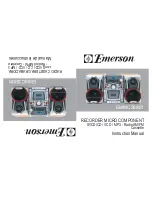
plugging this signal into the MX-2424 will register 6dB less then if a “balanced”
signal were sent to it.
To use this solution with other recorders we recommend that the manufacturer is
consulted as to what cable to use with their product.
For a DA-78HR or DA-38 use ¼” to RCA cables:
CU/SU302 6ft.
CU/SU303 10ft.
CU/SU304 13ft.
CU/SU305 16ft.
CU/SU307 23ft.
The DA-78HR and DA-38 have unbalanced inputs and we recommend that they
are used for this solution.
Tracking with channels 25-32
If only 8 tracks of simultaneous recording are necessary, mic/line inputs 1-8 can
be assigned to channels 25-32. Use busses 1-8 to buss the signal to tape
digitally and use channels 1-24 as digital tape return channels. This is also a
very easy way to work.
EFFECTS
The DM-24 has two internal effects processors. Processor #1 contains the TC
Works reverb (over 100 presets) and the Antares Mic and Speaker modeler. TC
works reverb and the Antares Speaker modeler cannot be used simultaneously.
Processor #2 contains TASCAM effects:
•
Chorus
•
Delay
•
Pitch
Shifting
•
Phaser
•
Flanger
•
Compressor
•
Guitar
compressor
•
Exciter
•
De-esser
•
Gate
•
Distortion (with amp simulators)
There are two locations called “Effect 1 and Effect 2” where these algorithms can
be loaded. The source of the inputs to Effects 1 and Effects 2 can be Aux sends
1-6. Effects returns can be assigned to any of the 32 channels. Effects 1 and 2
can also be routed as “inserts” on busses 1-8, Aux sends 1-6 or the stereo buss.
The internal effects can also be used with the “assignable” inserts. For instance,
if a fretless bass is on channel 2 and chorus needs to be added to it, assign the
chorus effect to assignable insert #1 and assign insert #1 to channel 2. Using
the assignable insert saves an aux send and two return channels.
Effect 1 and Effect 2 can also be run in series. This would allow you to run a
delay into a reverb, for instance.






























